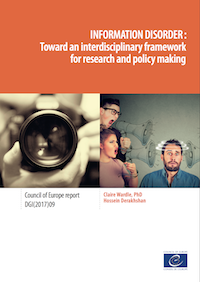Information Disorder

The report on “Information Disorder: Toward an interdisciplinary framework for research and policy making” is an attempt to comprehensively examine information disorder, its related challenges, and to outline ways to address information pollution.
Image © Shutterstock

“Information Disorder: Toward an interdisciplinary framework for research and policy making”
Read more
While the historical impact of rumours and fabricated content has been well documented, efforts to better understand today’s challenge of information pollution on a global scale are only just beginning. Concern about the implications of dis-information campaigns designed specifically to sow mistrust and confusion and to sharpen existing sociocultural divisions using nationalistic, ethnic, racial and religious tensions is growing.
The Council of Europe report on “Information Disorder: Toward an interdisciplinary framework for research and policy making” is an attempt to comprehensively examine information disorder and to outline ways to address it.
The report consciously refrains from using the term ‘fake news’ which is woefully inadequate to effectively capture the complexity of the phenomenon of information pollution, not to mention that it is increasingly becoming politicised.
The report therefore introduces a new conceptual framework for examining information disorder, identifying the three different types: mis-, dis- and mal-information. The differences between these three types of information are described using the dimensions of harm and falseness:
| Mis-information is when false information is shared, but no harm is meant. |
| Dis-information is when false information is knowingly shared to cause harm. |
| Mal-information is when genuine information is shared to cause harm, often by moving information designed to stay private into the public sphere. |
|
In trying to understand examples of information disorder, the report proposes to consider three elements: |
Similarly, the life of an example of information disorder is considered as having three phases: |
|
|
Dissecting information disorder in this manner helps to understand the nuances. A clear vision of the mechanism and all its elements allows for an understanding of who are the actors involved, motivations of each of them, assessing the scale and identifying ways to address the issue.
Revealing the causes
Read more
In order to effectively address information pollution, we need to understand the emotional and ritualistic elements of communication. The most ‘successful’ of problematic content is that which plays on people’s emotions and encourages feelings of superiority, anger or fear. This is also the type of content that is most liked and shared, often without actually having been read or understood. The report emphasises that the core purpose of communication between people, going far beyond the function of transmission of information, lies in representing shared beliefs.
When most social platforms are engineered for people to publicly ‘perform’ through likes, comments or shares, it’s easy to understand why emotional content travels so quickly and widely, even as we see an explosion in fact-checking and debunking organisations.
Identifying Solutions
Read more
Lengthy fact-checking and debunking of false information may come too late. It may also not reach the intended audience because it is not liked and shared. There is an urgent need to understand the most effective formats for sparking curiosity and scepticism amongst audiences about the information they consume and the sources from which that information comes. The collapse of local journalism is viewed as an important contributor to the success of disinformation, as such campaigns grow much faster amongst marginalised communities who mistrust mainstream media.
In addition to its conceptual framework, the report provides a round-up of related research, reports and practical initiatives connected to the topic of information disorder, as well as filter bubbles and echo chambers, and contains thirty-five recommendations for governments, technology companies, media organisations and civil society.
Aware of the close correlation between the information disorder phenomenon and the issue of quality journalism, as well as with digital and media literacy of internet users in general, the Council of Europe has tasked its Steering Committee on Media and Information Society (CDMSI) to carry out further research and standard-setting in the relevant fields.
The Council of Europe will continue to comprehensively address the phenomenon.
Two expert groups,
- the Committee of Expert on quality journalism in the digital age and
- the Committee of Experts on Human Rights Dimensions of automated data processing and different forms of artificial intelligence,
will explore in more detail what member states may do to promote a favourable environment for an independent, diverse and pluralistic media environment in which societies can both trust and actively participate in.

"Everyone has the right to freedom of expression"
Art. 10 European Convention on Human Rights


